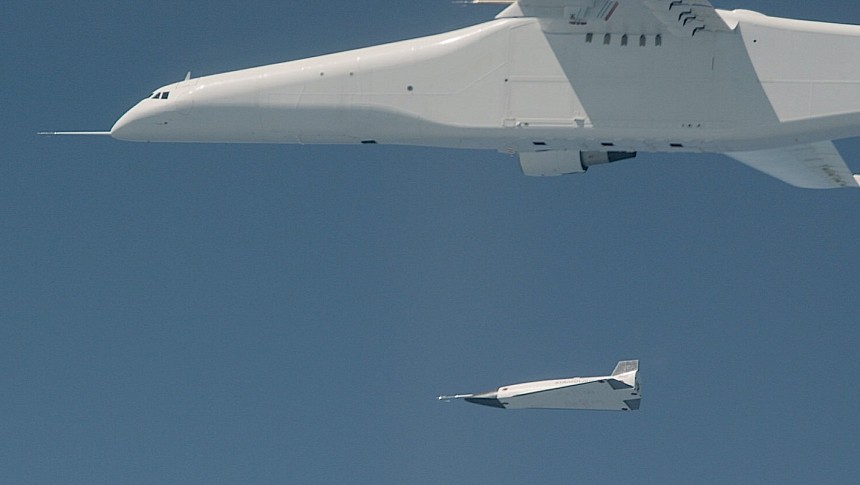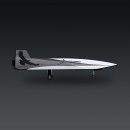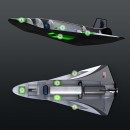Because they're so common now and also spectacular in nature, reusable space vehicles get all the prime-time news, no matter if they're launched vertically from a pad or horizontally from under the wing of an airplane.
Several companies though are not working on reusable space vehicles, but reusable hypersonic test beds. They're not here in full yet, but judging by an announcement made earlier this week by Stratolaunch, they'll soon be here, and just as in the headlines as spaceships.
Stratolaunch is involved in several projects at the moment, but the one that caught the eye (even that of the U.S. Air Force) is the Talon-A. As described by Stratolaunch, we’re talking about an autonomous testbed that could allow customers to put whatever technology through its paces at hypersonic speeds.
The Talon looks a lot like a missile, and can fly at speeds of over Mach 5 (3,800 mph/6,100 kph). It can carry inside it a variety of payloads that need to be put through trials and tribulations, provided it departs from a suitable launch platform.
That suitable launch platform is the Roc, a twin-fuselage airplane Stratolaunch has been using for a while now. The weird contraption is presently the largest aircraft by wingspan in the world, at 385 feet (117 meters).
It was this machine Stratolaunch used to once again let the Talon loose during a recent test mean to put through its paces the separation release procedure.
The Roc flew, for the second time, over the Vandenberg Space Force Base's Western Range in California. The trip lasted a little over four hours and was meant to prove "the Talon-A launch system can cleanly and safely separate hypersonic vehicles from Roc's center-wing pylon."
Because the Talon is nothing more than a testbed for technologies, the telemetry it is capable of sending back to the ground was also tested.
"Our hardware and data collection systems performed as anticipated, and we now stand at the precipice of achieving hypersonic flight," said in a statement Dr. Zachary Krevor, Stratolaunch CEO.
Now that this hurdle has been cleared, all eyes are on the first hypersonic test for the Talon. Scheduled to take place in late summer, it should make it obvious to anyone interested that the hardware works as designed.
If it does, the Roc-Talon pair will become something unlike anything else out there. The USAF knows this, and it supports the program through the U.S. Air Force Research Laboratory (AFRL).
It's not entirely clear at this point when the supersonic aircraft will fly for the first time on an actual mission, but some people are already talking about a version of it being capable of doing the same with a crew on board.
Stratolaunch is involved in several projects at the moment, but the one that caught the eye (even that of the U.S. Air Force) is the Talon-A. As described by Stratolaunch, we’re talking about an autonomous testbed that could allow customers to put whatever technology through its paces at hypersonic speeds.
The Talon looks a lot like a missile, and can fly at speeds of over Mach 5 (3,800 mph/6,100 kph). It can carry inside it a variety of payloads that need to be put through trials and tribulations, provided it departs from a suitable launch platform.
That suitable launch platform is the Roc, a twin-fuselage airplane Stratolaunch has been using for a while now. The weird contraption is presently the largest aircraft by wingspan in the world, at 385 feet (117 meters).
It was this machine Stratolaunch used to once again let the Talon loose during a recent test mean to put through its paces the separation release procedure.
The Roc flew, for the second time, over the Vandenberg Space Force Base's Western Range in California. The trip lasted a little over four hours and was meant to prove "the Talon-A launch system can cleanly and safely separate hypersonic vehicles from Roc's center-wing pylon."
Because the Talon is nothing more than a testbed for technologies, the telemetry it is capable of sending back to the ground was also tested.
"Our hardware and data collection systems performed as anticipated, and we now stand at the precipice of achieving hypersonic flight," said in a statement Dr. Zachary Krevor, Stratolaunch CEO.
Now that this hurdle has been cleared, all eyes are on the first hypersonic test for the Talon. Scheduled to take place in late summer, it should make it obvious to anyone interested that the hardware works as designed.
If it does, the Roc-Talon pair will become something unlike anything else out there. The USAF knows this, and it supports the program through the U.S. Air Force Research Laboratory (AFRL).
It's not entirely clear at this point when the supersonic aircraft will fly for the first time on an actual mission, but some people are already talking about a version of it being capable of doing the same with a crew on board.

















